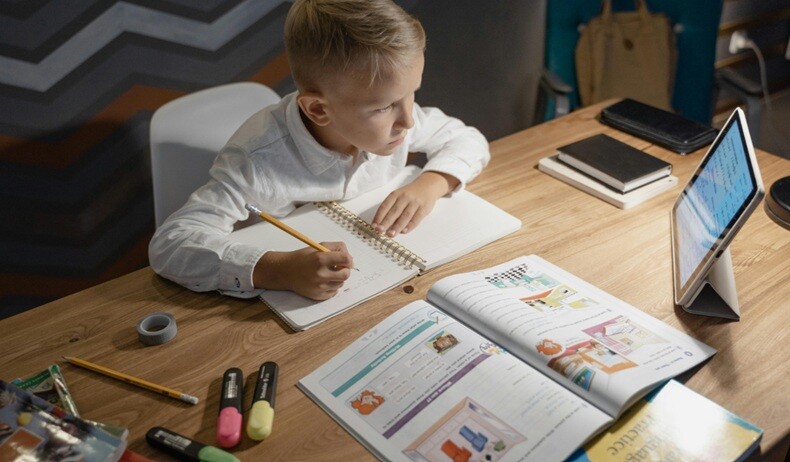When hybrid instruction was originally implemented in schools, the objective was straightforward: maintain student safety while maintaining class operations. But a surprising event occurred. As classes shifted from in-person to online settings, educators noticed that students were presenting themselves in different ways.
While the tech-savvy ones were assisting peers with projects, the quiet, reserved students were making in-depth posts on the internet. Engagement began to imply something new, and learning began to feel more collaborative.
What started as an emergency action quickly turned out to be a long-term advantage: hybrid instruction presented a new avenue for a deeper and more adaptive interaction with students. Schools found new ways of connecting students, motivating and engaging them in their learning processes through the help of technology, personalization, and a renewed sense of inclusivity.
Redefining What Engagement Looks Like
For decades, student engagement was often measured by classroom behavior. That is, whether the pupil shows up, pays attention, or responds when called upon. Hybrid instruction shifted that perception entirely. Teachers began to realize that true engagement wasn’t about who spoke the loudest, but who was thinking, contributing, and connecting with ideas.
Engagement in hybrid classes went beyond in-person contact. After class, students might participate in online discussions, which would allow them to think things out before speaking. A lot of people started investigating teaching using videos, collaborative digital spaces, and multimedia platforms. Others demonstrated initiative in collaborative projects that integrated online and in-person work, finding novel applications for their acquired knowledge.
Schools were able to acknowledge previously invisible types of involvement because of this expanded concept. Just as involved as a student taking part in a debate in class was a student writing an insightful web post or doing a video project. Schools created learning settings where all voices could be heard by rethinking how involvement is communicated.
Personalization as the New Pathway to Engagement
As hybrid systems developed, educational institutions started utilizing data and technology to customize the learning experience for each student. Learning management systems included information on comprehension levels, completion rates, and involvement. Teachers were able to modify classes to reflect each student’s progress by observing which pupils were succeeding and which were lagging.
The effect of being able to customize their education was a strong sense of ownership among students. As soon as they saw activities and lessons that interested them and were at their own pace, they gained more motivation. Schools also began adapting artificial intelligence (AI) to improve education. Settling learning gaps, suggesting more readings, and offering adaptive tests to give the student just the right level of challenge are all achieved with these AI-powered tools.
This evidence-based practice substituted the universal model with a more adaptive system that does not ignore the learners’ individual differences. Those who used to have difficulties keeping pace with the lesson were helped out, and those who were willing to move ahead could work on more advanced material. The more applicable and personalized the learning process, the greater the level of student attachment and interest remained.
Reimagining the Teacher’s Role
The change in teachers themselves was arguably the biggest motivator for engagement. Educators had to revamp their teaching methods to become more participatory and immersive as a result of the transition to hybrid instruction. Instead of merely imparting knowledge, teachers evolved into facilitators who aided students in developing critical thinking abilities, promoted teamwork, and supported inquiry.
Many schools have also updated their classrooms with the appropriate audiovisual technology to enable interactive learning, making it smooth, captivating, and easily accessible. This technology made it possible for both local and distant students to take an equal part in group projects, experiments, and discussions.
In addition, teachers tried various activities, such as online reflection boards, breakout sessions, multimedia presentations, and live polls. Students may work together on a shared document at the end of a class that starts with a live discussion and ends with a digital quiz.
Lessons were more entertaining, and focus was maintained because of these different forms. As a result, regardless of the kids’ learning backgrounds, the classroom environment promoted creativity and curiosity.
Making Learning More Inclusive and Flexible
By increasing access and involvement, hybrid instruction also changed how students engaged. Traditional classroom settings were not necessarily the most encouraging for a large number of children. Others had to deal with issues like long commutes or domestic duties, while others battled social anxiety. These pupils now have more comfortable studying and contributing opportunities thanks to hybrid learning.
Being adaptable became crucial. Pupils had the option to engage in lectures that were recorded, finish assignments at various times, or both. In order to accommodate varying learning requirements and preferences, educators started creating lessons that provided several opportunities for participation.
This diversity empowered the feeling of belonging in the students. Students became more active when they believed that their situation and communication patterns were not overlooked. It was demonstrated that in hybrid instruction, the level of engagement increases because students are not limited to a single format. Instead, they are given the ability to learn in the way that is most effective for them.
Building Systems That Sustain Engagement
The road to creating effective hybrid instructional models was not easy. Schools faced real obstacles: unreliable internet access, limited digital tools, and the steep learning curve of mastering new platforms. However, instead of stepping back, teachers and administrators used these obstacles to improve their methods.
Schools trained teachers in blended learning techniques and made investments in more robust digital infrastructure. Programs for professional development focused on meaningful integration of technology. This led to improved lessons in coherence, accessibility, and engagement over time.
Moreover, the curricula were adjusted to have a greater focus on teamwork and creativity. Traditional tests were often substituted with project-based exams, which required students to engage with the concepts in a real-world setting. The more interesting learning system that came about following these structural adjustments motivated students to engage in the process and think more critically.
Conclusion
Hybrid instructional techniques were not just a band-aid answer; they were the beginning of a paradigm shift in the way schools view and promote student involvement. Individualization, inclusion, and cautious use of technology were integrated to create a learning environment that cultivates participation instead of making it compulsory.
Since they feel like active participants in their education, students are now more engaged. Teachers are more equipped and have greater freedom to create learning experiences that appeal to each student. Students and their teachers will become even more connected as long as innovation continues, from AI-assisted learning to improved classroom technology.
In the end, hybrid instruction changed more than where learning happens. It changed how it feels. The current level of engagement is now based on making students feel that they are competent, inquisitive learners with a voice in their learning. That shift, more than any platform or device, is what has truly transformed the classroom experience.
You may also like to read,










